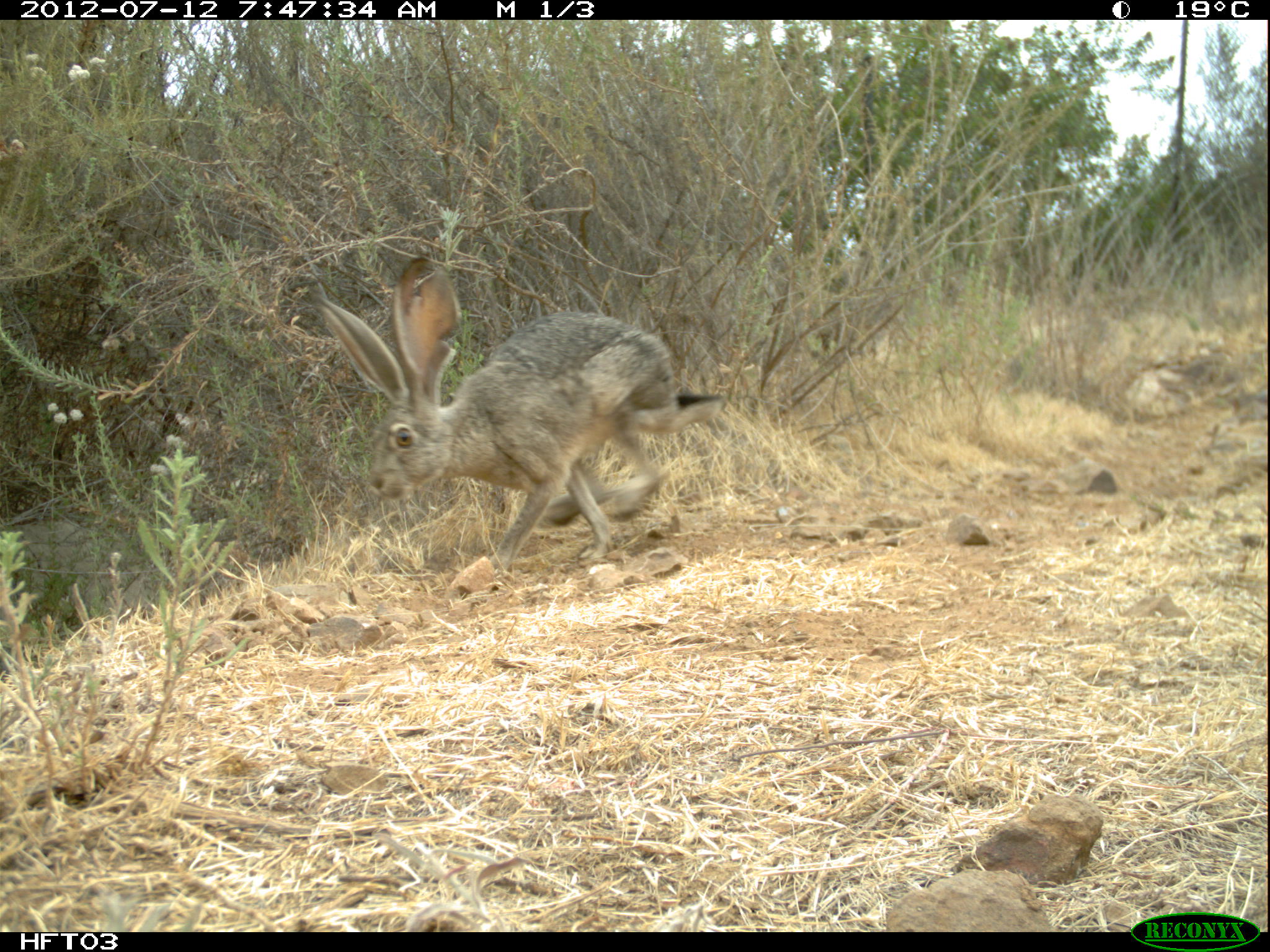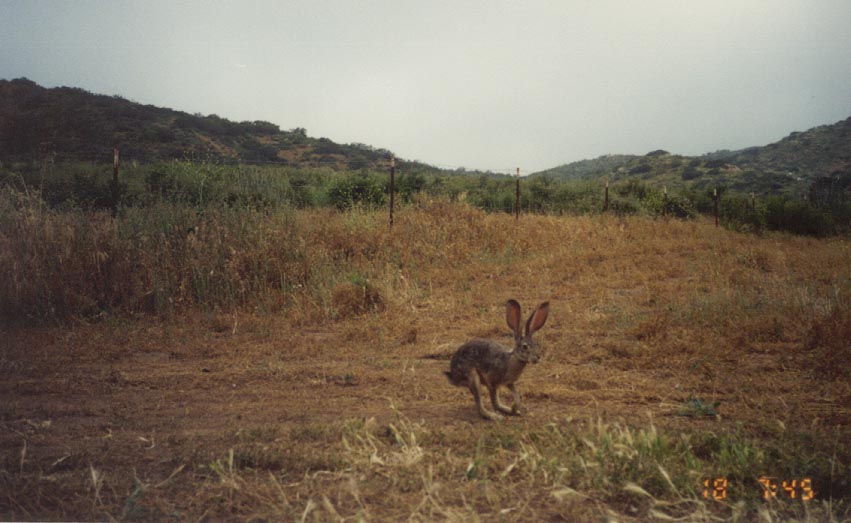Goals and Objectives
Goal: Maintain, enhance and restore coastal sage scrub, native grassland and forblands, and manage nonnative grassland on Conserved Lands in the MSPA that supports or has the potential to support VF species (i.e., cliff spurge, Palmer's goldenbush, San Diego barrel cactus, snake cholla, Blaineville's horned lizard, California gnatcatcher, grasshopper sparrow, San Diego black-tailed jackrabbit) and to incidentally benefit a diverse array of other species (e.g., San Diego thornmint, Quino checkerspot, burrowing owl, coastal cactus wren, golden eagle, Stephen's kangaroo rat) so that populations of these VF and other species are resilient to environmental stochasticity, threats and catastrophic disturbances, very large wildfires, invasive plants and prolonged drought, and will be likely to persist over the long term (>100 years).
Regional
NFO
2018
VF
MON-PRP-MONPL LEPCAL-1
Management units: 1, 2, 3, 4, 5, 6, 7
In 2018, develop a long-term San Diego Black-tailed Jackrabbit Monitoring Plan to track their distribution and status, habitat associations and level of threats in coastal sage scrub and grassland vegetation communities across the MSPA. The plan should integrate with the Chaparral, Coastal Sage Scrub and Grassland Vegetation Monitoring Plan to include sampling at long-term vegetation monitoring plots. The monitoring plan should build upon previous surveys, habitat assessments and modeling to develop specific questions, monitoring methods, a statistically valid sampling design, sampling locations, and standardized protocols for determining the status and abundance of the jackrabbit and for assessing habitat and threats at each sampling site to determine vegetation management needs. The plan should include guidelines for data analysis and preparation of a report with monitoring results and vegetation management recommendations.
| Action |
Statement |
Action status |
Projects |
| PRP-1 |
Submit project metadata and San Diego Black-tailed Jackrabbit Monitoring Plan to the MSP Web Portal. |
On hold |
|
| Criteria |
Deadline year |
| San Diego Black-tailed Jackrabbit Monitoring Plan completed in 2018 |
2021 |
Regional
NFO
2019
VF
MON-IMP-MONPL LEPCAL-2
Management units: 1, 2, 3, 4, 5, 6, 7
In 2019, begin implementing long-term San Diego black-tailed jackrabbit monitoring as specified in the San Diego Black-tailed Jackrabbit Monitoring Plan. Prepare a report detailing jackrabbit and habitat and threat assessment results and with site specific vegetation management recommendations.
| Action |
Statement |
Action status |
Projects |
| IMP-1 |
Submit project metadata, datasets, analyses and monitoring report with management recommendations to the MSP Web Portal. |
waiting for precedent action |
|
| Criteria |
Deadline year |
| San Diego Black-tailed Jackrabbit Monitoring and Report completed by 2020 |
2021 |
Current Distribution Rangewide
Ranges from Los Padres National Forest
southward and west of the peninsular range into northwestern Baja California, Mexico [1].
Known Populations in San Diego County
Within the MSPA, San Diego black-tailed jackrabbit is found in MUs 1, 3, 4, and 6 [2].
List Status
CDFW- SSC [3].
Habitat Affinities
Occurs primarily in arid regions with short grass [4]. Preferred habitats include open grasslands, agricultural fields, and sparse coastal scrub.
Not typically found in high grass or dense brush. Nesting sites are generally under bushes or shrubs that have shallow depressions and are occasionally lined with fur [4].
Taxonomy and Genetics
The San Diego black-tailed jackrabbit (Lepus californicus bennettii) is a subspecies of the black-tailed jackrabbit (Lepus californicus), also known as black-tailed hare [5]. San Diego black-tailed jackrabbit occurs only on the coastal side of the southern California mountain range where habitat for the species is less suitable due to loss of habitat, fragmentation, and isolation of populations due to agriculture and urbanization.
Seasonal Activity
Activity patterns are year-long diurnal and crepuscular [6]. Consumption patterns change seasonally. Diet primarily consists of a variety of grasses during spring and summer, with various shrubs and forbs consumed to some extent during fall and winter [7].
Life History/Reproduction
The breeding season length generally depends on the duration and severity of winter [8]. In southern California, black-tailed jackrabbit are known to breed throughout the entire year. Gestation normally lasts 40 days, and a single female can produce 10 to 18 leverets (young rabbits) in one breeding season [9]. Reproduction varies depending on environmental conditions. Juveniles make up the majority of the population. Adults make up less than 30 percent of the population and are estimated to live less than 7 years in the wild.
Diet and Foraging
Strictly herbivorous, primarily feeding on a wide variety of grasses [6]. Will also feed on forbs and shrubs during fall and winter.
Dispersal
Home ranges averaging 45 acres have been recorded in California [4].
Threats
Populations declining in Southern California as a result of development, hunting, pest control, and agricultural land conversions [6].
Special Considerations:
The population sizes and distributions of San Diego black-tailed jackrabbit’s display natural fluctuations in relation to reproduction and densities of food resources, making it difficult to survey and census jackrabbit populations [4].
Literature Sources
[1] Hall, E. R. 1981. The Mammals of North America. Second ed. John Wiley & Sons, New York, 1:1-303.
[2] MSP-MOM. 2016. Management Strategic Plan Master Occurrence Matrix.
[3] California Department of Fish and Wildlife, Natural Diversity Database. July 2017.
Special Animals List. Periodic publication. 51 pp.
[4] Leichleitner, R. R. 1958. Certain aspects of behavior of the black-tailed jack rabbit. Journal of Mammalogy, 38:481-485.
[5] Stephenson, J.R.; Calcarone, G.M. 1999. Southern California mountains and foothills assessment: Habitat and species conservation issues. General Technical Report GTR-PSW-175. Albany, CA: Pacific Southwest Research Station, Forest Service, U.S. Department of Agriculture.
[6] Zeiner, D.C.; Laudenslayer, W.F., Jr.; Meyer, K.E.; White, M., eds. 1990. California's wildlife. Volume III: Mammals. California statewide wildlife habitat relationships system. Sacramento, CA: California Department of Fish and Game.
[7] Johnson R. D., and J. E. Anderson. 1984 Diets of black-tailed jack rabbits in relation to population density and vegetation. J. Range Manage. 37:79-83.
[8] Best, T.L. 1996. Lepus californicus. Mammalian Species. No. 530. American Society of Mammalogists. Bond, S.I. 1977. An annotated list of the mammals of San Diego County, California. In: Transactions of the San Diego Society of Natural History 18(14): 229–248.
[9] Bronson, F. H., and O. W. Tiemeier. 1958. Reproduction and age distribution of black-tailed jack rabbits in Kansas. The Journal of Wildlife Management. 22:409-414.

